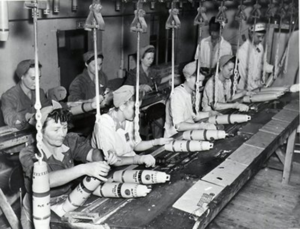Ajax as a Coastal Industry:
Ajax as a Coastal Industry:
Munitions Production During World War II
Sarah Smart
Port2Port - 2025
Located approximately 40 kilometers east of Toronto, the Town of Ajax played a significant role in the manufacturing of munitions for the British allies in World War II. In 1941, a munitions production factory called Defense Industries Limited (DIL) opened in Ajax, Ontario, pictured in Figure 1.1 This was one of the largest wartime factories in the British Empire during the Second World War.2 The growth of Defense Industries Limited had an immense impact on the once rural Ajax, creating a booming wartime industry that has had a long-lasting impact on Ajax today .3 Many Men and women across Canada looking for work were recruited by the National Selection Service to move to Ajax and work for DIL to support the home front war effort .4

Figure 1: Munitions workers at Defense Industries Limited during WWII.
The significance of Ajax as a location for the DIL cannot be underestimated. Located along Lake Ontario, Ajax, and the Great Lakes in general, provided a strategic location for munition plants to operate .5 Ajax provided a safe hub for DIL, as it was far enough away from the Atlantic Ocean that there was minimal fear of a German or Japanese attack .6 Ajax was isolated from the violence of the war, which raises the question: One why didn't DIL set up operations on Canada's East Coast near the Canadian Navy? This is because the East Coast of Canada is located on the Atlantic Ocean, making it more susceptible to German attack. Had DIL been located in Nova Scotia, the plant would have been vulnerable to potential risk. Working in munition factories was a dangerous occupation that left no room for error. The sensitive nature of the job itself and the explosives manufactured meant that if an enemy attack were to occur, it would risk a devastating outcome. Overall, having DIL away from Canadian seaports eliminated the threat of German attack.
Another advantage to DIL's location at Ajax was its proximity to the Canadian National Railroad. Munitions were shipped by rail to Canada's east coast then shipped to Britian across the Atlantic Ocean. The railroad was an important mode of transportation for both munitions and factory workers travelling to Ajax. working with DIL.7 Railroads in Canada are placed along the Great Lakes, meaning much of the population of Canada in the 1940s and even today, are located along the Great Lakes. Moreover, from a coastal standpoint, Ajax was the best location for Defense Industries Limited as it was far enough away from enemy threats, but close enough to transportation lines for munitions to be carried safely.
Defense Industries Limited were some of Ajax's earliest coastal industries. In January 1946, months after the armistice of the Second World War, DIL was in the process of converting the munitions factory into a satellite campus for the University of Toronto for Engineering studies .8 Continuing the legacy of DIL, Ajax produced a significant fraction of Canadian engineers during the post war era.9
Some may argue that DIL was the nucleus of the Town of Ajax. Its role in WWII left a lasting impact on the town's industrial identity. The war effort not only put Ajax on the map as a thriving coastal hub but also forged a community whose origins are still remembered today for their resilience and innovation.
-
Figure 1: [Munitions workers at Defense Industries Limited during WWII], photograph, Ajax Public Library, n.d. ↩
-
Lisa Tubb, "Assembling Victory, Defense Industries Limited, Ajax, 1941-1945," Ontario History 111, no. 1 (2019), 1. ↩
-
Tubb, "Assembling Victory," 2. ↩
-
Tubb, "Assembling Victory," 3. ↩
-
Ernest Forbes, "Consolidating Disparity: The Maritimes and the Industrialization of Canada during the Second World War," Acadiensis 15, no.2 (1986), 5. ↩
-
Forbes, "Consolidating Disparity," 5. ↩
-
Hugh Newton, "Who's to Pay Way Home Ajax Girls Wondering: Girl War Workers Want Fairs Paid Back West as Promised," The Globe and Mail, Mar. 12, 1945. ↩
-
Jean-Louis Trudel, "Born in War: Canada's Postwar Engineers and Toronto's Ajax Division," Scientia Canadensis 21, no. 50 (1997), 9. ↩
-
Trudel, "Born in War," 22. ↩

